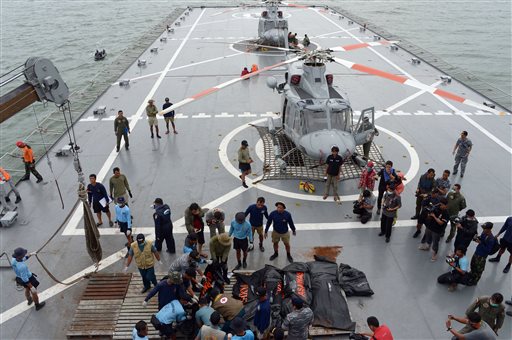2 large objects found in AirAsia wreckage hunt

Indonesian’s Navy personnel prepare the dead bodies of the passengers of AirAsia Flight 8501, on Indonesian navy vessel KRI Banda Aceh, to transfer them by helicopters at sea off the coast of Pangkalan Bun, Indonesia, Saturday, Jan. 3, 2015. AP
PANGKALAN BUN, Indonesia — Indonesian officials were hopeful Saturday they were honing in on the wreckage of AirAsia Flight 8501 after sonar equipment detected two large objects on the ocean floor, a full week after the plane went down in stormy weather.
Teams equipped with a remote-operated vehicle were battling high waves and strong currents as they tried to capture images of the suspected chunks of the plane for confirmation, said Henry Bambang Soelistyo, chief of the National Search and Rescue Agency.
An Indonesian navy ship detected the objects early Friday, and by midnight, searchers had zoomed in with a Geological Survey vessel to take dimensions
One of the objects was measured at 9.4 meters by 4.8 meters (31 feet by 15 feet) and a half-meter (20 inches) high. The other, found nearby, was 7.2 meters (24 feet) by a half meter (20 inches).
“I’m confident this is part of the AirAsia plane,” said Soelistyo.
Article continues after this advertisementThe Airbus A320 carrying 162 passengers and crew crashed last Sunday, halfway into a two-hour flight from Surabaya, Indonesia’s second-largest city, to Singapore. Minutes before losing contact, the pilot told air traffic control he was approaching threatening clouds, but was denied permission to climb to a higher altitude because of heavy air traffic.
Article continues after this advertisementIndonesian authorities announced the grounding of AirAsia flights from Surabaya to Singapore, with the Transport Ministry saying the airline did not have a permit to fly on Sundays, the day of the crash.
AirAsia, which began operations in 2001, quickly becoming one of the region’s most popular low-cost carriers, said it was reviewing the suspension. The crash on Dec. 28 was the airline’s first.
So far, only 30 corpses have been recovered, a few still strapped in their seats. Bad weather and waves, sometimes 4 meters (13 feet) high, have slowed efforts, scattering bodies and debris farther and farther away. An emergency exit door and slide were among the discoveries, as a backpack with food, camera and children’s food.
It remains unclear what caused the plane to plunge into the Java Sea, though bad weather appears to have been a factor, according to a 14-page report released by Indonesia’s Meteorology, Climatology and Geophysics Agency.
“Flight 8501 appears to have been trapped in bad weather that would have been difficult to avoid,” the report said.
As part of the investigation into the crash, autopsies will be carried out on some of the bodies, including the pilot and co-pilot, whose remains have not yet been recovered, said Budiyono, who heads East Java’s Disaster Victim Identification unit and uses only one name.
Generally, aviation experts say the more passengers, luggage and parts of the aircraft that remain intact indicate the plane hit the water in one piece. That would signal problems like a mechanical error or a stall instead of a midair breakup due to an explosion or sudden depressurization.
RELATED STORIES
Leaked radar data hints AirAsia plane rose, fell very fast
Doomed AirAsia flight schedule unauthorized—Indonesian transport exec